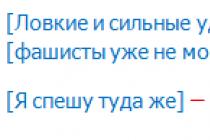Despite the fact that, according to the church charter, Maslenitsa does not exist as such a holiday (in the church calendar this period is designated as a week of preparation in Lent and is called Cheese Week), people love this mass celebration and actively take advantage of the opportunity to have a lot of fun before starting preparation for Easter. Considering that the date when Maslenitsa in 2019 is tied to the date of Easter, you need to know what date Easter is so as not to make a mistake and not break the rules of Lent. In 2019, Easter will be on April 28, and the period when Maslenitsa begins will be March 4-10, the week that precedes the beginning of Lent. What is the history of the formation of the holiday and what traditions are followed by the people during this period?
Yarilo is a symbol of the sun and the beginning of spring
Turning to the history of the formation of Maslenitsa week, you can find out that it was customary to celebrate the holiday back in the days of paganism. During the period when the festivities were taking place, a large effigy of Yarila was taken out on the street, which symbolized the god of the sun, spring and fertility. In honor of the god Yarila and the sun, people baked flat cakes in a special way: they took a handful of flour into their palm, dipped it in water, and from the resulting dough they baked ruddy flat cakes that personified the solar disk. Later, flat cakes began to be baked from dough and sourdough. According to tradition, when biting a piece of flatbread, a person seemed to be biting off a piece of the sun, along with its energy and warmth.

The attitude of the Orthodox Church towards Maslenitsa
Even before Christianity arose, the Maslenitsa period began a week before the spring equinox, and continued for another week after it.
With the emergence of Christianity in Rus', new holidays appeared, but the celebration of Maslenitsa remained among the people. However, there was a slight difference: the dates of the holiday shifted due to the beginning of Lent. Due to pagan remnants, people continued to follow the traditions of burning effigies, dancing in circles, and walking as hard as they could.

After the baptism of Rus', the church tried to resist this kind of festivities, but still some traditions remained. Nowadays, people continue to burn effigy and jump over the fire on Maslenitsa. So what is the attitude of the modern church to such an event?
Today, the clergy remind all believers that Cheese Week is, first of all, a period of preparation for the most important fast - Lent, and therefore it is better to abandon such festivities and spend Maslenitsa in moderate fun. Indeed, during the period of Great Lent, a person is not allowed to eat food of animal origin, in order to cleanse the soul, one must also repent of the united, pray, and spend more time thinking about the meaning of life and one’s purpose. The church has nothing against having fun on Maslenitsa and eating pancakes, but it recommends keeping yourself within the bounds of reason, especially not abusing alcoholic beverages, since it is believed that such drinks alienate a person’s soul from God, and vice versa, bring him closer to demons alcoholism.

But the church has nothing against the tradition of visiting your friends and loved ones on Maslenitsa and serving them homemade pancakes with different fillings. On the contrary, priests emphasize the importance of such a tradition, since it is believed that you need to spend more time with your loved ones, listen to them and share your current affairs, since during Lent you should partially give up communication, devoting this time to yourself, prayers and God .
Maslenitsa week: how the festivities take place, holiday traditions
Of course, the most famous and beloved Maslenitsa tradition is baking. The tradition, like the holiday itself, has pagan roots. Round, rosy pancakes with a golden crust represented the sun. In ancient times, during festivities, people decorated cart wheels and carried them around, while whistling cheerful melodies. All this was carried out in order to “butter” the sun, to appease Yarila, so that he would be favorable. By the way, this is where the name of the holiday came from – “Maslenitsa”.

Another well-known tradition of this holiday is jumping over a fire. It was believed that by jumping over a fire, a person would burn away his sins. Today, if somewhere at Maslenitsa events this kind of fun is organized, it is done more for the sake of fun. If we talk about sin from the point of view of Christianity, then the believer needs to visit the temple and atone for his sins there, and not jump over the fire.

Also, the tradition of burning effigy has survived to this day as a symbol of the passing of winter and the beginning of spring. By burning the effigy, people asked for a fruitful year.

Forgiveness Sunday
The date when Maslenitsa 2019 begins is March 4, and Maslenitsa days end on Sunday, March 10. This Sunday is called Forgiveness Sunday. On this day, one should sincerely ask for forgiveness from everyone and remember the departed. On Forgiveness Sunday in churches there are evening services dedicated to the rite of forgiveness. The rector of the temple asks for forgiveness from the parishioners, and they, in turn, ask for forgiveness from each other. At the same time, when someone asks for forgiveness on Forgiveness Sunday, one must respond with the following words: “God will forgive.”
Maslenitsa is a wonderful spring feast that leaves in the memory and heart the warmth and joy of the exciting celebration. Historically, it is a traditional pagan festival, since it appeared long before the emergence of Christianity. As a rule, in 2017 it is customary to celebrate Maslenitsa throughout the last week before Lent, exactly seven weeks before the bright Orthodox holiday - Easter.
In short, the oil dish is dedicated to welcoming a beautiful, fragrant spring and seeing off a cold, sparkling winter. And now more about this magical celebration, in which there is so much pleasant and joyful to the soul.
History of folk festivals
As mentioned above, Maslenitsa is a traditional pagan festivities and rituals that were observed and celebrated long before the advent of Christianity.
The main goal of this grandiose fun and celebration is to spend the winter with honors and welcome the beautiful spring with open arms. The traditional attributes of this feast are pancakes of all kinds with any fillings, chants, walks, and, of course, the burning of a straw effigy representing winter.
 Maslenka in 2017 is another bright, cheerful, ringing holiday. Delving into history, it should be noted that the pancake, the main participant in the grandiose action, personifies and has always personified the sun. After all, if you look closely at him, you can really see that he is round and ruddy, like the sun. And it’s also hot if you eat it right out of the heat.
Maslenka in 2017 is another bright, cheerful, ringing holiday. Delving into history, it should be noted that the pancake, the main participant in the grandiose action, personifies and has always personified the sun. After all, if you look closely at him, you can really see that he is round and ruddy, like the sun. And it’s also hot if you eat it right out of the heat.
During the entire celebration, people walk, drink for mood and to warm up, eat pancakes with all kinds of fillings (sour cream, red caviar, butter, herring, jam, honey and many, many others), sing songs, dance as best they can, play the folk instruments (accordions, harp, button accordions, balalaikas, etc.) and much, much more.
The most important, culminating event of Shrovetide week is the grandiose burning of the effigy of winter. Usually this is a large doll made of straw and fabric, several meters in height. Before burning, everyone gathers around the effigy, mentally or out loudly says goodbye to winter and thanks it for ending, and finally, the effigy is set on fire. An immense flame flares up, symbolizing the voluntary departure of winter and the coming of spring.
This is a short history of this wonderful celebration of spring. Surprisingly, Cheese Week 2017 is no different from its previous celebrations, which were organized by our ancestors.
The beginning of the oiler - when exactly does it begin?
As already written above, the cheese week (also its name) is traditionally celebrated during the last week before Lent. The exact dates for the start of this feast change every year, since Easter falls on a different date every year.

Shrovetide 2017 will be celebrated in a big way from February 20 to 26. During this week, on each of its days, thematic meetings and rituals will be held. Each day will be dedicated to a specific purpose, thus the holiday will be filled with colors and events and will leave a lot of emotions and impressions.
Cheerful traditions of a bright and ringing welcome to spring
So, what will happen on each of the 7 days of Maslenitsa 2017? What traditions are inherent in each day of the holiday week?
On the first day of Shrovetide, it is customary to go sledding down the hill and at the same time tell fortunes. If the sleigh goes smoothly and far, it means that the coming year will bring an excellent and rich harvest.
On the second day, according to tradition, great gatherings and celebrations begin. Young guys and girls start communicating, so far on a friendly note. People walk, sing songs, ride slides and enjoy the holiday.
The most delicious day of the butter dish begins on Wednesday. The feast begins. Enjoying treats and great food. The main dish of any table is pancakes. Lacy, lush, thin - you name it! Not to mention the variety of toppings. Pancakes are the centerpiece and decoration of the table. 
Thursday is the middle of the celebration. The fun is just beginning. It is unknown how popular the Pancake Thursday tradition is now. But before, young people began to ride horses in circles. According to tradition, if you make at least one circle on the sled, the sun will begin to warm up.
The fifth day of Maslenitsa 2017 is also a pancake day. But not simple, but related. The son-in-law and his relatives should come to visit his beloved mother-in-law and taste her pancakes.
Saturday – pancakes again delight with their abundance and beauty. Relatives visit each other and enjoy pancakes and other festive dishes.
The seventh and final day of Shrovetide is Sunday. The main day of this wonderful holiday. Since this is the last day before Lent, on Sunday it is customary to ask everyone for forgiveness for everything and forgive yourself. The culmination of this day is, as before, the burning of a straw effigy of winter, huge round dances around the fire, soulful songs and joy that spring has come.
Final day: details, details
The culmination of the 2017 oil can is its final day. Once again, huge tables are set, bursting with treats and an abundance of the main dish - pancakes, with many fillings.
Another feature is forgiveness of everyone and everything on this day. A kind of cleansing of the soul and conscience from everything bad before Lent.
The main, most delicious part of the last day of Maslenitsa 2017 is the traditional burning of a huge straw effigy, symbolizing the bygone winter. And, of course, the coming joy from the understanding that spring has already come. This marks the end of the great Maslenitsa holiday and folk festivities.

Cheese Week (another name) is a wonderful celebration. Maslenitsa in 2017 is another reason to prepare for the celebration, create your own program, get everything done and fully experience all the emotions from these festivities and celebrations. Treating yourself to pancakes prepared with love, sleigh rides, songs, walks, burning an effigy of winter - it’s unforgettable and worth spending a whole week on fun!
And in conclusion, a video about the traditions of Maslenitsa.
Ecuadorian authorities have denied Julian Assange asylum at the London embassy. The founder of WikiLeaks was detained by British police, and this has already been called the biggest betrayal in the history of Ecuador. Why are they taking revenge on Assange and what awaits him?
Australian programmer and journalist Julian Assange became widely known after the website WikiLeaks, which he founded, published secret documents from the US State Department in 2010, as well as materials related to military operations in Iraq and Afghanistan.
But it was quite difficult to find out who the police, supporting by the arms, were leading out of the building. Assange had grown a beard and looked nothing like the energetic man he had previously appeared in photographs.
According to Ecuadorian President Lenin Moreno, Assange was denied asylum due to his repeated violations of international conventions.
He is expected to remain in custody at a central London police station until he appears at Westminster Magistrates' Court.
Why is the President of Ecuador accused of treason?
Former Ecuadorian President Rafael Correa called the current government's decision the biggest betrayal in the country's history. “What he (Moreno - editor’s note) did is a crime that humanity will never forget,” Correa said.
London, on the contrary, thanked Moreno. The British Foreign Office believes that justice has triumphed. The representative of the Russian diplomatic department, Maria Zakharova, has a different opinion. “The hand of “democracy” is squeezing the throat of freedom,” she noted. The Kremlin expressed hope that the rights of the arrested person will be respected.
Ecuador sheltered Assange because the former president had left-of-center views, criticized U.S. policies and welcomed WikiLeaks' release of secret documents about the wars in Iraq and Afghanistan. Even before the Internet activist needed asylum, he managed to personally meet Correa: he interviewed him for the Russia Today channel.
However, in 2017, the government in Ecuador changed, and the country set a course towards rapprochement with the United States. The new president called Assange “a stone in his shoe” and immediately made it clear that his stay on the embassy premises would not be prolonged.
According to Correa, the moment of truth came at the end of June last year, when US Vice President Michael Pence arrived in Ecuador for a visit. Then everything was decided. “You have no doubt: Lenin is simply a hypocrite. He has already agreed with the Americans on the fate of Assange. And now he is trying to make us swallow the pill, saying that Ecuador is supposedly continuing the dialogue,” Correa said in an interview with the Russia Today channel.
How Assange made new enemies
The day before his arrest, WikiLeaks editor-in-chief Kristin Hrafnsson said that Assange was under total surveillance. “WikiLeaks uncovered a large-scale spy operation against Julian Assange at the Ecuadorian embassy,” he noted. According to him, cameras and voice recorders were placed around Assange, and the information received was transferred to the Donald Trump administration.
Hrafnsson clarified that Assange was going to be expelled from the embassy a week earlier. This did not happen only because WikiLeaks released this information. A high-ranking source told the portal about the plans of the Ecuadorian authorities, but the head of the Ecuadorian Foreign Ministry, Jose Valencia, denied the rumors.
Assange's expulsion was preceded by the corruption scandal surrounding Moreno. In February, WikiLeaks published a package of INA Papers, which traced the operations of the offshore company INA Investment, founded by the brother of the Ecuadorian leader. Quito said it was a conspiracy between Assange and Venezuelan President Nicolas Maduro and former Ecuadorian leader Rafael Correa to overthrow Moreno.
In early April, Moreno complained about Assange's behavior at Ecuador's London mission. “We must protect the life of Mr. Assange, but he has already crossed all boundaries in terms of violating the agreement that we came to with him,” the president said. “This does not mean that he cannot speak freely, but he cannot lie and hack.” ". At the same time, back in February last year it became known that Assange at the embassy was deprived of the opportunity to interact with the outside world, in particular, his Internet access was cut off.
Why Sweden stopped its prosecution of Assange
At the end of last year, Western media, citing sources, reported that Assange would be charged in the United States. This was never officially confirmed, but it was because of Washington’s position that Assange had to take refuge in the Ecuadorian embassy six years ago.
In May 2017, Sweden stopped investigating two rape cases in which the portal’s founder was accused. Assange demanded compensation from the country's government for legal costs in the amount of 900 thousand euros.
Earlier, in 2015, Swedish prosecutors also dropped three charges against him due to the expiration of the statute of limitations.
Where did the investigation into the rape case lead?
Assange arrived in Sweden in the summer of 2010, hoping to receive protection from American authorities. But he was investigated for rape. In November 2010, a warrant was issued for his arrest in Stockholm, and Assange was put on the international wanted list. He was detained in London, but was soon released on bail of 240 thousand pounds.
In February 2011, a British court decided to extradite Assange to Sweden, after which a number of successful appeals followed for the WikiLeaks founder.
British authorities placed him under house arrest before deciding whether to extradite him to Sweden. Breaking his promise to the authorities, Assange asked for asylum at the Ecuadorian embassy, which was granted to him. Since then, the UK has had its own claims against the WikiLeaks founder.
What awaits Assange now?
The man was re-arrested on a US extradition request for publishing classified documents, police said. At the same time, Deputy Head of the British Foreign Ministry Alan Duncan said that Assange would not be sent to the United States if he faced the death penalty there.
In the UK, Assange is likely to appear in court on the afternoon of April 11. This is stated on the WikiLeaks Twitter page. British authorities are likely to seek a maximum sentence of 12 months, the man's mother said, citing his lawyer.
At the same time, Swedish prosecutors are considering reopening the rape investigation. Attorney Elizabeth Massey Fritz, who represented the victim, will seek this.
Maslenitsa, also called Cheese or Maslenitsa week, is celebrated by Orthodox believers during the 8th week before Easter, from Monday to Sunday. The week-long celebration of Maslenitsa is preceded by the most important and strict fast in the Orthodox Church - Great Lent 2019.
The date on which Maslenitsa week begins is not constant, as it depends on the date of Easter. In 2019, Easter is celebrated on April 28, and, accordingly, Maslenitsa will begin on March 4, 2019, and end on March 10, 2019.
That is, Maslenitsa week in 2019:
The final day of Maslenitsa (in 2019 - March 10, 2019) is called Forgiveness Sunday and is the culmination of a week-long celebration. On this day they ask each other for forgiveness, and at sunset they burn an effigy, which is the embodiment of frosty time.
It is interesting that Maslenitsa festivities coincide with the period of Cheese Week, which among the Orthodox is considered quite strict, precedes Lent and ends with Forgiveness Sunday. On the same day, according to pre-Christian traditions, an effigy of Maslenitsa is burned. The Church not only does not prohibit, but also supports public festivities during Maslenitsa week, seeing in them an opportunity for people to meet with family and friends and ask them for forgiveness before fasting. Maslenitsa traditions for an Orthodox Christian should be filled with missionary meaning.
- Monday. On the first day, pancakes are baked and guests are welcomed at home. This is a reason to invite all your relatives, all your friends whom you haven’t seen for a whole year and ask for their forgiveness.
- Tuesday. Flirting or viewing. On this day, the guy’s relatives came to the house of the girl he liked and wooed him. If we managed to agree, then there should have been a wedding on Krasnaya Gorka.

- Wednesday. "Mother-in-law's pancakes." On Wednesday, the wife's mother sets the table and invites her son-in-law to visit. It is believed that the more abundant the food, the more the mother-in-law loves her daughter’s husband.
- Thursday. It's time for folk festivals. Everyone goes out into the street, treats each other to pancakes, communicates, and plays folk games.
- Friday. This day is called "Mother-in-law's evening." On Friday, the mother-in-law goes to visit her son-in-law. It was believed that such gatherings help to improve relationships between generations in the same family.
- Saturday. Sister-in-law's get-togethers, when the wife invites her husband's sister to the house and treats her to pancakes. This tradition helps the young daughter-in-law get to know her new relatives better.
- Sunday. Forgiveness Sunday in the Orthodox tradition and the day of farewell (burning) of Maslenitsa, which has come to us since pre-Christian times.

HOW ARE THE DATES OF TRANSIBLE HOLIDAYS DETERMINED?
All moving Orthodox holidays are associated with Easter. Back in 325, at the First Ecumenical Council, the rule for celebrating the Resurrection of the Lord was established. Then it was determined that all churches supporting Orthodoxy would celebrate Easter on the first full moon of spring. The date of transition from winter to spring was set as the day of the vernal equinox, according to the Julian calendar it is March 21.
At the Council, Emperor Constantine made a proposal to divide the Christian and Jewish holiday. The fact is that the Resurrection of the Lord occurred when the Jews celebrated their Easter, associated with the events of the Exodus from Egypt. In 325, apostolic canons were adopted, one of which stated that the bishop who would celebrate Easter with the Jews would be excommunicated.
In 1054, a schism occurred among Christians, and in 1583 the Gregorian calendar was adopted in the Roman Catholic Church and the rule was established to celebrate the Resurrection of Christ on the first Sunday after the first full moon, which occurs after the vernal equinox, but according to the new calendar. For Catholics, Easter Day often coincides with or precedes a Jewish holiday.
The beginning of Maslenitsa is counted from Easter. To do this, it is necessary to retreat 56 days ago from the Resurrection of the Lord. Festive festivities continue for a whole week and end with the fasting of Lent.

PROGRAM OF EVENTS IN MOSCOW FOR MASLENITSA 2019
Maslenitsa is traditionally very widely celebrated in the capital of our Motherland. In Moscow for Maslenitsa week 2019, approximately forty venues will be organized where a wide variety of events will take place. Here you can:
- take part in various competitions and sports competitions;
- take part in master classes;
- watch performances of folk groups;
- take part in interesting quests;
- visit fairs and attractions;
- try pancakes with a variety of fillings, etc.
Each district of the capital has prepared its own program of events. It will be especially fun in parks and squares. Here, together with the buffoons, you can dance in circles and take part in various fun and games. The most significant places in the capital will be decorated with interesting art objects. The most visited areas will traditionally be:
- Gorky, Krasnaya Presnya, Izmailovo, Kuzminki, Tagansky and others parks;
- Bauman Gardens and the Hermitage;
- Manezhnaya and Revolution squares;
- New Arbat;
- Tverskoy Boulevard;
- Pushkinskaya embankment;
- Profsoyuznaya street, etc.
The city will be decorated with ice and straw figures of Maslenitsa and national toys of various sizes.
A wide animation program will be organized for children. Children will be able to take part in interactive performances prepared by professional and amateur groups.
FEATURES OF THE CELEBRATION OF THE FIRST THREE DAYS OF MASLENITSA

Another tradition is when the mother-in-law and her husband send their daughter-in-law home to her parents so that she can prepare a festive table for them. And in the evening the whole family reunites at a large table, the main dish of which is, of course, pancakes. The fillings can be very different: red or black caviar, salted or fried mushrooms, meat, sweet cottage cheese, grated apples, poppy seeds, condensed milk, jam, jam, whatever suits your taste. In addition to the above, a scarecrow is created on this day; it is made from straw and old clothes, and a pumpkin is used for the head. It is customary to take such a stuffed animal around the yards and show it to people.
On the second day of the holiday, young people took part in bride viewings, because this cannot be done during Lent, and it is also forbidden to have a wedding; the ban loses force only after its end. On this day, theatrical performances began, the actors in which were ordinary people from the people; as a rule, at such events the audience was made to laugh by buffoons.
On the third day, the girl’s husband goes to visit his mother-in-law, who will treat him with pancakes. The young man can bring his friends with him. The mother-in-law also invites guests on her part; she must show herself to be a hospitable hostess and feed the guests to their fullest. And for the evening, festivities are planned, during which you can drink hot tea with honey gingerbread cookies and enjoy other treats on the street in specially designated places.
On Wednesday on Maslenitsa, when people gathered on the street and the snow had not yet subsided, they took sleighs with them and rode them down the mountains and hills, and also sang holiday songs.
FEATURES OF CELEBRATING THE LAST FOUR DAYS OF MASLENITSA

On the fourth day, large celebrations, masquerade processions, fairs, concerts, and theatrical performances were held in cities and villages. At this time, on the streets one could taste national cuisine, cold, hot and snacks. You could drink warming and invigorating drinks. There were also various sweets for children. We rode harnessed horses. They made fires and gathered around them to warm themselves.
On Friday, the mother-in-law and her husband came to visit the young couple and the hospitable hosts were supposed to organize a big celebration. The older generation was invited to visit to gain worldly wisdom from them and listen to advice. Other relatives and friends should also be invited. The daughter should show her mother what a good housewife she is and thank her for everything she taught her about how to run a household.
On the sixth day, the fun and festivities continued, people visited booths, circuses, theaters, and restaurants. In the evening, people gathered around the family hearth at the festive table. On this day, it is customary to invite your sister-in-law to your home. In this way, other relatives are also invited to please the husband.
On Sunday, all celebrations ended, people took a break from festivities and feasts. And the main ritual was considered to say goodbye to the scarecrow created on the first day of the holiday. It was a symbolic farewell, saying goodbye not only to the scarecrow, but also to winter. He was burned at the stake. So that winter recedes and spring comes into its own.
Published 02/18/17 14:10When is Maslenitsa in 2017, how to celebrate this holiday - this and much more.
Maslenitsa in 2017: what date?
These days, Russians celebrate one of the people's most beloved and riotous holidays - Maslenitsa. Celebrations on the occasion of this holiday last for a whole week.
Maslenitsa in 2017 starts on February 20 and ends on the 26th, and on February 27, Orthodox believers enter Lent.
On Maslenitsa it is customary to organize mass celebrations, go to visit, have fun and, of course, not deny yourself gastronomic pleasures and, of course, bake the main intkbbach symbols of the holiday - pancakes.
The celebration of Maslenitsa in 2017 coincides with a long weekend for Russians on the occasion of February 23, so many regional authorities are planning to celebrate their beloved folk holidays on a grand scale.
Maslenitsa 2017: what you can and cannot do
You should never be sad on Maslenitsa. It is believed that if you spend the holiday properly, tasty and satisfying, then the whole next year will be just as rich and fruitful. In addition, after Maslenitsa, as mentioned above, Great Lent begins, so before long spiritual and physical abstinence, believers hurried to eat properly and get some exercise.
Pancakes are baked throughout Maslenitsa week. It is also customary to visit each other and treat each other with delicious delicacies. People organize parties and have fun until they drop. During this week, it is not forbidden to make some noise in the company of dear people, spend time in city squares, eat pancakes and drink hot tea.
Maslenitsa 2017: pancakes - recipe
We bring to your attention a simple recipe for pancakes for Maslenitsa. Even the most inexperienced cook can make this dish. So, pancakes are prepared from a glass of flour, two eggs, a glass of milk, a pinch of salt, two tablespoons of sugar, as well as a pinch of salt and two tablespoons of vegetable oil. All ingredients are mixed until a homogeneous mass, reminiscent of kefir in consistency, and then the resulting dough is fried in portions in a preheated, pre-oiled frying pan.














